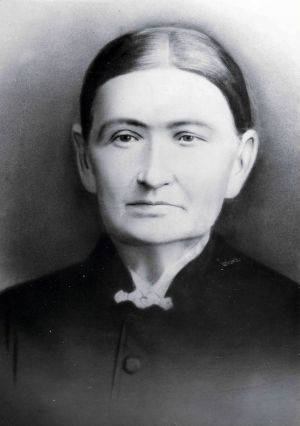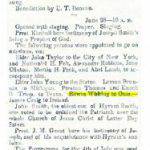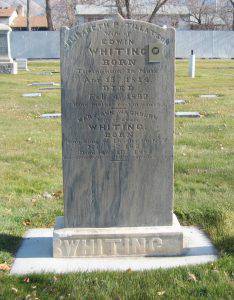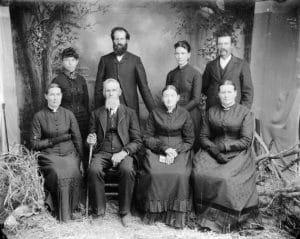
The incidents in this story are true and are taken from papers and letters in the possession of Teressa Fullmer Johnson, great granddaughter of Elizabeth P. Tillotson Whiting. Some of the letters are more than 100 years old. This is NOT a first-person account, but rather an account written in the voice of Elizabeth by William S. Johnson, therefore there are some historical discrepancies with other Whiting histories.

My name is Elizabeth Partridge Tillotson. I was born on April 15, 1814, in Tyringham, Berkshire County, Massachusetts. I was one of fourteen children born to Sarah Partridge and Samuel Tillotson. They were humble, average New England people. While I was still a child, my parents and the rest of the family, including myself, moved to Nelson, Ohio. I was extremely interested in education and received all the education available to me in those frontier days. This education served me well when I later became a school teacher, teaching frontier children the fundamentals of learning.
One day while still living in Ohio, I met Edwin Whiting. We fell in love and were married September 21, 1833. Shortly after we were married, we learned of a new religion, fathered by Joseph Smith. We were so impressed by the principles and teachings set forth by the Prophet Joseph Smith, we joined the Latter Day Saint Church and received a testimony of its truthfulness. So strong was our faith, we left our home and moved to Kirtland, Ohio.
During my early church association, I received numerous letters from my family, particularly from my sister Polly, who criticized me for accepting the Gospel and joining the Church. If only I could impress upon them the truthfulness of the Gospel. Polly wrote that the Book of Mormon had originally been written as a novel but that certain men had felt that it would have greater sales as a religious work.
Stirred by bitter men, the feelings of the townspeople of Kirtland turned against us Mormons. Angry mobs forced us to flee our home, escaping only with our clothing, bedding and our lives. And while we were living in Lima, Illinois a group of hateful men forced their way into our homes. They had waited until the men of the Mormon families were away helping to guard the prophet Joseph Smith. On that horror-filled night, the only Mormon home that was spared was that of father Elisha Whiting, who was so ill that he could not be moved from his bed. Fires were set to all the homes and buildings. The brightest flame in the night was that of the Whiting chair shop. Valuable lumber and expensive machinery shot showers of sparks into the air. My daughter, Sarah, who was three years old at the time, clapped her hands and danced about as if at a party at seeing the great number of enormous bonfires. Great was the fear in my heart, as I spent the night huddled on a pile of blankets we managed to save, trying every way to keep the baby Emily, who was sick, comforted and warm.
The next morning, teams came from Nauvoo. We loaded our meager possessions on to wagons and moved to a new home in Nauvoo. Edwin helped to erect the temple there. Great was our joy to enjoy the teachings and companionship of the Prophet Joseph.
“A group of crazed and angry men have killed the Prophet Joseph Smith, breaking their way into the Carthage jail where Joseph and others were being held. They shot him.”
Once more we were forced to flee from our homes by angry mobs. After leaving Nauvoo, we settled for a while at Mt. Pisgah, Union County, Iowa. While we were there, Edwin was president of the branch for a few seasons. Sorrow came to us at Mt. Pisgah where my darling daughter Emily, who was six years old at the time, passed away. Added sorrow came to us when father Elisha Whiting and his wife Sally contracted malarial fever during an epidemic and also passed away. Their names are inscribed on the monument there. This monument was erected by the Church, honoring the many Saints who rest there in unmarked graves.
So great was our faith that we heeded the call of our leaders — in 1849. We undertook the task of crossing the plains to Utah. Day after dreary day crept slowly by as we trudged our way onward. My five children and I walked most of the way. We braved numerous hardships and suffered many trials. My wagon was next to that of George A. Smith. His wife, Bathsheba, and I became fond friends. Elder Smith was in charge of 50 wagons in Ezra T. Benson’s train of 100 wagons.
Finally our goal was almost in sight as we slowly fought our way up the slopes of what is known as South Pass. As we started to assent, snow began to fall. As we neared the summit, the storm had grown into a raging blizzard. For three days we were beaten by the falling snow and the howling winds. Numerous cattle and other live stock were lost in the deep snow and bitter cold. At last, tired and weary, we worked our way through the pass and into the valley below. We arrived in Salt Lake Valley in November, 1849. But upon our arrival, Brigham Young asked us to go with Morley’s company to start a new settlement in the area, which was later to be known as Manti in Sanpete County. With our foot-sore oxen, it took us three weeks to travel from Salt Lake City to the sight of our new settlement. After leaving Provo it was necessary to make our own trails and to build several dugways and bridges in order to continue our journey, which ended the latter part of November.
A large band of Indians, numbering about 500, were already living in the area. We made dugouts in the hillsides where we spent the winter. We shared our meager possessions with the Indian band.
Snow fell very deep and all our cattle and oxen perished of starvation. The Indians were constantly begging for food. When spring finally came the Indians left to go to their hunting grounds in southern Utah. But they left behind the aged mother of the chief, who was too feeble and weak to make the trip. They placed her in a hole in the ground, left her a jug of water to drink and a piece of dried venison to eat. They covered her with brush and left her to die. Some children found her there before she died so she was taken to the home of Bishop Aaron Johnson for special care. She lived for several years, unknown to the chief, though he would have been very angry if he had found out the whole story.
I was very shocked at the treatment the Indians gave to their old people. When one became old and feeble, they would tie his feet to a horse with a rope and drag him over the rough rocky ground to their burial place, which was on the south side of what is now temple hill.
Edwin went to Salt Lake to sell the chairs, which he had made during the winter. These chairs were made out of timber, which he had pulled down by hand from the canyon himself. He had fashioned the seats out of rawhide. With the money he received, we were able to buy food and supplies for the family.
My daughters, Caroline and Louisa were born in our primitive, humble dugout home. The city, which we had settled was named Manti, and it was decided by the Church authorities to build a temple there.
Our dugout was located at the bottom of temple hill. One spring a great multitude of rattlesnakes crawled from the rocks of temple hill and invaded our homes, causing great fear and terror among us. However, thanks to God, no one was ever bitten.
In 1855, Edwin was called to go on a mission to the East. While he was gone, a plague of grasshoppers descended upon the valley and destroyed all our crops. I spun wool, made straw hats and knit socks for my neighbors to procure food for my children. In the fall, my son William and I drove by ox team to Springville where William tearfully allowed me to exchange his pet colt for a wagonload of corn.
After the marriage of my daughter Amelia to Archibald Buchanan, and my daughter Sarah to Bishop Warren Snow of Manti, and my son William to Rebecca Losee, Edwin and I and our four children, Lucius, Oscar, Louisa, and Caroline, moved to Springville.
I was delighted and pleased to hear from my sister Polly, to learn that she had joined the LDS Church. I was very happy to receive each one of her letters. We have kept in touch through the years even though it takes great lengths of time for our letters to be delivered. I knew in my heart that she had made the right decision. Her daughter, Sarah, later married Lorenzo Snow, who was later to become the President of the LDS Church.
I had the privilege of serving as counselor in the first Primary in Springville along with Zabonia Alleman and Mary Crandall.
The twilight years of my life were spent in a comfortable home surrounded by an abundance of fruits and flowers. I have lived a full life, have had a wonderful husband and family. I truly have been blessed by the Lord.
Elizabeth Partridge Tillotson Whiting died February 4, 1892 and was buried beside her beloved husband in the Springville Cemetery. She was a kind and gentle home-loving person. She was loved by all.”
Compiled by William S. Johnson – May 1955, From Marie J. Whiting Collection



No comment yet, add your voice below!